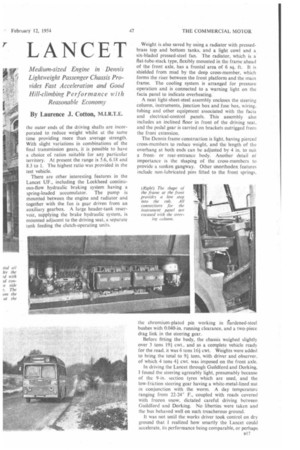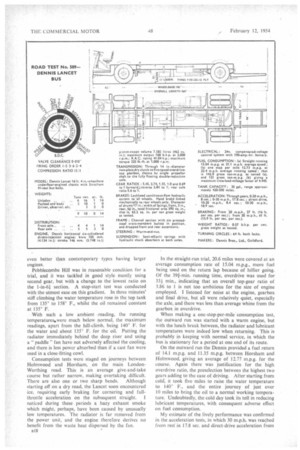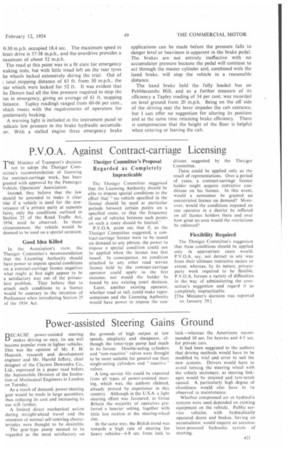A LIV1 LANCET
Page 50

Page 51

Page 52

Page 55

If you've noticed an error in this article please click here to report it so we can fix it.
By Laurence J. Cotton, M.I.R.T.E.
AMEDIUM-SIZED oil engine of good torque characteristic in a light chassis provides a spirited performance with reasonable economy for the latest Dennis Lancet underfloor-engined bus. This model is unusual in that its main frame is foreshortened at the frontand rear-spring anchorage points, and the dropped front extension carries the controls. Because the driver is seated below the main floor level, the passenger. visibility to the front is improved, and low platforms can be used for frontor rear-entrance bodies.
In redesigning the Dennis 7.585-litre engine for underfloor mounting, a new cylinder block is used to reduce overall height, and the water pump and dynamo share a tandem drive on top of the crankcase. The timing gear is arranged at the flywheel end of the engine and the fuel-injection .pump is operated from the rear of the camshaft. Modifications to the manifolding and governed speed have raised the output to 108 b.h.p. at 2,000 rpm, and 325 lb.-ft. torque is derived at 1,000 r.p.m.
The_engine is offset in the frame, with the cylinder block below a side member, and the crankshaft is in line with the final drive of the rear axle. It is good practice that the injection pump, cylinder heads, and connections which have to be freed for top inspection, are all accessible from outside the-vehicle. This not only saves time but prevents any possibility of the interior and upholstery being soiled by mechanics. The engine oilfiller neck and radiator filler are extended to the near side of the frame, and a 35-gal. fuel tank is arranged on the opposite side.
A two-plate dry clutch and Dennis five-speed overdrive-top gearbox are attached direct to the engine, with hydraulic operation for the clutch to reduce linkage. The gearbox, a standard unit with preselective control between the direct and overdrive ratios, is turned from the normal horizontal position so that the selector cover is nearer the top_ This provides an easier connection to the gear lever. Whilst the three lower ratios of the box are " crash " engaged, the fourth and fifth gears are engaged through dog clutches with a spring-loaded toggle arrangement to afford preselection.
A special two-piece aide case with spiral-bevel gears. offset from the centre, and epicyclic gear-reduction at at 6 the outer ends of the driving shafts are incorporated to reduce weight whilst at the same time providing more than average strength. With slight variations in combinations of the final transmission gears, it is possible to have a choice of ratios suitable for any particular territory. At present the range is 5,6, 6.18 and 8.3 to 1. The highest ratio was provided in the test vehicle.
There are other interesting features in the Lancet UF., including the Lockheed continuous-flow hydraulic braking system having a spring-loaded accumulator. The pump is mounted between the engine and radiator and together with the fan is gear driven from an auxiliary gearbox. A large header-tank reservoir, Supplying the brake hydraulic system, is mounted adjacent to the driving seat, a separate tank feeding the clutch-operating units.
Weight is also saved by using a radiator with pressedbrass top and bottom tanks, and a light cowl and a six-bladed pressed-steel fan. The radiator, which is a. flat-tube-stack type, flexibly mounted in the frame ahead of the front axle, has a frontal area of 6 sq. ft. It is shielded from mud by the deep cross-member, which forms the riser between the front platform and the main frame. The cooling system is arranged for pressure operation and is connected to a warning light on the facia panel to indicate overheating..
A neat light-sheet-steel assembly encloses the steering column, instruments, junction box and fuse box, wiring, tubing and other equipment associated with the facia and electrical-control panels. This assembly also includes an inclined floor in front of the driving seat, and the pedal gear is carried on brackets outrigged from the front extension.
The Dennis frame construction is light, having pierced cross-members to reduce weight, and the length of the overhang at both ends can be adjusted by 4 in. to suit a frontor rear-entrance body. Another detail of importance is the shaping of the cross-members to provide a sunken gangway. Other unorthodox features include non-lubricated pins fitted to the front springs, the chromium-plated pin working in llardened-steel bushes with 0.040-in, running clearance, and a two-piece drag link in the steering gear.
Before fitting the body, the chassis weighed slightly over 3 tons 19/ cwt., and as a complete vehicle ready for the road, it was 6 tons 161 cwt. Weights were added to bring the total to 9i tons, with driver and observer, of which 4 tons 41 cwt. was imposed on the front axle.
In driving the Lancet through Guildford and Dorking, I found the steering agreeably light, presumably because of the 9-in. section tyres which are used, and the low-friction steering gear having a white-metal-lined nut in conjunction with the worm. A day temperature ranging from 22-24° F., coupled with roads covered with frozen snow, dictated careful driving between Guildford and Dorking. No liberties were taken and the bus behaved well on such treacherous ground.
It was not until the works driver took control on dry ground that I realized how smartly the Lancet could accelerate, its performance being comparable, or perhaps even better than contemporary types having larger engines.
Pebblecombe Hill was in reasonable condition for a trial, and it was tackled in good style mostly using second gear, but with a change to the lowest ratio on the 1-in-6.1 section. A stop-start test was conducted with the utmost ease on this gradient. In three minutes' stiff climbing the water temperature rose in the top tank from 135° to 158° F., whilst the oil remained constant at 135° F.
With such a low ambient -reading, the running temperaturesovere much below normal, the maximum readings, apart from the hill-climb, being 140° F. for the water and about 135° F. for the oil. Putting the radiator immediately behind the deep riser and using a " paddle " fan have not adversely affected the cooling, and there is less power absorbed than if a cast fan were used in a close-fitting cowl.
Consumption tests were staged on journeys between Holmwood and Horsham, on the main LondonWorthing road. This is an average give-and-take course but rather narrow, making overtaking difficult. There are also one or two sharp bends. Although starting off on a dry road, the Lancet soon encountered ice, requiring early braking for cornering and fullthrottle acceleration on the subsequent straight.
noticed during these periods a hazy exhaust smoke which might. perhaps, have been caused by unusually low temperatures. The radiator is far removed from the power unit, and the engine therefore derives no benefit from the waste heat dispersed by the fan.
1118 ln the straight-run trial, 20.6 miles were covered at an average consumption rate of 15.04 m.p.g., more fuel being used on the return lap because of hillier going. Of the 39f-min. running time, overdrive was used for 331 min., indicating that an overall top-gear ratio of 3.86 to 1 is not too ambitious for the size of engine employed. 1 listened for noise at the engine, gearbox and final drive, but all were relatively quiet, especially the axle, and there was less than average whine from the gearbox in overdrive.
When making a one-stop-per-mile consumption test, the outward run was started with a warm engine, but with the lunch break between, the radiator and lubricant temperatures were indeed low when returning. This is probably in keeping with normal service, in which the bus is stationary for a period at one end of its route.
On the outward run the Dennis provided a fuel return of 14.1 m.p.g. and 11.35 m.p.g. between Horsham and Holmwood, giving an average of 12.77 m.p.g. for the course. Again there was justification for the high overdrive ratio, the preselection between the highest two gears adding to the case of driving. After starting from cold, it took five miles to raise the water temperature to 140° F., and the entire journey of just over 10 miles to bring the oil to a normal working temperature. Undoubtedly, the cold day took its toil in reducing lubricant temperatures, with consequent adverse effect on fuel consumption.
My estimate of the lively performance was confirmed in the acceleration tests, in which 30 m.p.h. was reached from rest in 17.8 sec. and direct-drive acceleration from 0-30 m.p.h. occupied 18.4 sec. The maximum speed in lirect drive is 37-38 m.p.h., and the overdrive provides a naximum of about 52 m.p.h.
The road at this point was in a fit state for emergency waking tests, but with little tread left on the rear tyres he wheels locked extensively during the trial. Out of
total stopping distance of 63 ft. from 30 m.p.h., the .ear wheels were locked for 52 ft. It was evident that he Dennis had all the line pressure required to stop the nis in emergency, giving an average of 61 ft. stopping listance. Tapley readings ranged from 60-66 per cent., vhich meets with the requirements of operators for gentlemanly braking.
A warning light is included in the instrument panel to ndicate low pressure in the brake hydraulic accumulaor. With a stalled engine three emergency brake applications can be made before the pressure falls to danger level or heaviness is apparent in the brake pedal. The brakes are not entirely ineffective with no accumulator pressure because the pedal will continue to act through the master cylinder and, combined with the hand brake, will stop the vehicle in a reasonable distance.
The hand brake held the fully loaded bus on Pebblecombe Hill, and as a further measure of its efficiency a Tapley reading of 34 per cent, was recorded on level ground from 20 m.p.h. Being on the off side of the driving seat the lever impedes the cab entrance, but I. can offer no suggestion for altering its position and at the same time retaining brake efficiency. There is compensation that the height of the floor is helpful when entering or leaving the cab.




































































































